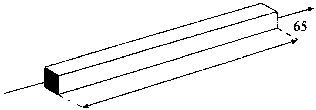
PA04
June 2003 part B
Answer all questions.
You
are advised to spend approximately one
hour on this section.
1 A microwave transmitter directs waves towards a metal plate. When a microwave detector is moved along a line normal to the transmitter and the plate, it passes through a sequence of equally spaced maxima and minima of intensity.
(a)
Explain how these maxima and minima are formed.
You may be awarded marks for
the quality of written communication in your answer
(b) The detector is placed at a
position where the intensity is a minimum. When it is moved a distance of 144 mm
it passes through nine maxima and reaches the ninth minimum from the starting
point.
Calculate
(i) the wavelength of the microwaves.
(ii) the frequency of the
microwave transmitter.
2
Communications
satellites are usually placed in a geo-synchronous
orbit.
(a) State two
features of a geo-synchronous orbit.
(2 marks)
(b) Given that the mass
of the Earth is 6.00 x 104 kg and its mean radius is 6.40 x 106m,
(i) show
that the radius of a geo-synchronous orbit must be 4.23 x 107 m
(ii) calculate the
increase in potential energy of a satellite of mass 750 kg when it is raised from the Earth’s surface into a
geo-synchronous orbit.
(6 marks)
3
(a) The equation F
= BIl,
where the symbols have their usual meanings, gives the magnetic force that acts
on a conductor in a magnetic field.
Give the unit of each of the quantities in the equation.
F
B
I
l
State the condition under which the equation applies.
(2 marks)
(b) The diagram shows a horizontal copper bar of 25 mm x 25mm square cross-section and length l carrying a current of 65 A.

(i) Calculate the minimum value of the flux density of the magnetic field in which it should be placed if its weight is to be supported by the magnetic force that acts on it.
density of copper = 8.9 x 103kgm-3
(ii) Draw an arrow on the diagram above to show the direction in which the magnetic field should be applied if your calculation in part (i) is to be valid. Label this arrow M.
(5
marks)
4
(a) With reference to the process of nuclear fusion, explain why energy is
released when two small nuclei join together, and why it is difficult to make
two nuclei come together.
You
may be awarded marks for the quality of written communication in your answer.
(3 marks)
(b)
A fusion reaction takes place when two deuterium nuclei join, as
represented by
21
H +
21 H
à
32 He
+ 10
n
mass
of 2H nucleus
= 2.01355 u
mass of 3He nucleus
= 3.01493 u
mass of neutron
= 1.00867 u
Calculate
(i) the
mass difference produced when two deuterium nuclei undergo fusion,
(ii) the
energy released, in J, when this reaction takes place.
(3 marks)